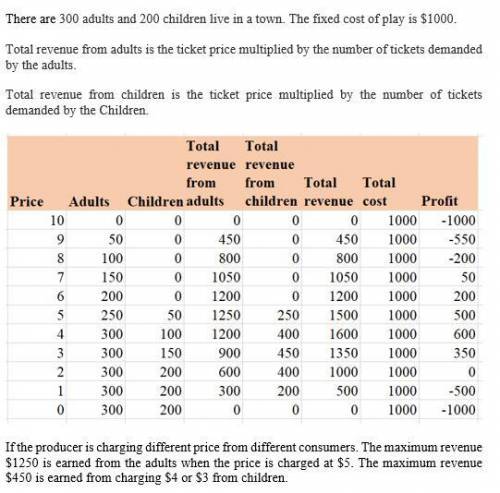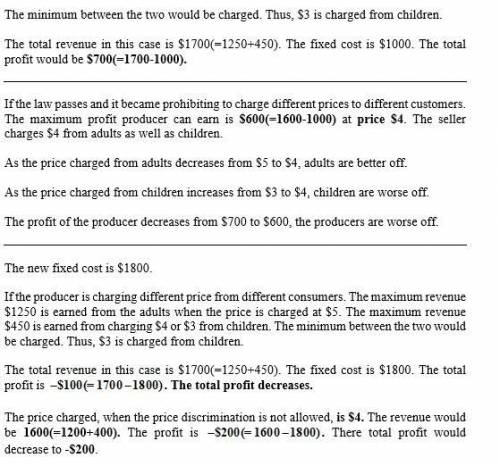
Business, 05.05.2020 04:26 lalaokawami0912
You live in a town with 300 adults and 200 children, and you are thinking about putting on a play to entertain your neighbors and make some money. A play has a fixed cost of $1,000, but selling an extra ticket has zero marginal cost.
Here are the demand schedules for your two types of customers:
Price Adults Children
(Dollars) (Tickets) (Tickets)
10 0 0
9 50 0
8 100 0
7 150 0
6 200 0
5 250 50
4 300 100
3 300 150
2 300 200
1 300 200
0 300 200
To maximize profit, you would charge for an adult's ticket and for a child's ticket . Total profit, in this case, would be .
The city council passes a law prohibiting you from charging different prices to different customers. Now you set a price of for all tickets, resulting in profit.
Indicate whether each of the following groups of people is better off, worse off, or the same because of the law prohibiting price discrimination.
Group of People Better Off Worse Off Unchanged
Adults
Children
You, the Producer
Suppose the fixed cost of the play were $1,800 rather than $1,000.
Complete the following sentences indicating how this would change your answers to the previous parts.
In the presence of price discrimination, the adult price of a ticket would , and the child price would .
Total profit would to .
If price discrimination were banned and the monopolist continued to produce the play no matter what the profit, the price of a ticket would , and total profit would to .

Answers: 2
Another question on Business

Business, 21.06.2019 23:30
Minneapolis federal reserve bank economist edward prescott estimates the elasticity of the u.s. labor supply to be 3. given this elasticity, what would be the impact of funding the social security program with tax increases on the number of hours worked and on the amount of taxes collected to fund social security?
Answers: 2

Business, 22.06.2019 03:00
Insurance companies have internal controls in place to protect assets, monitor the accuracy of accounting records and encourage operational efficiencies and adherence to policies. these internal controls are generally of two types: administrative controls and accounting controls. administrative controls are the policies and procedures that guide the daily actions of employees. accounting controls are the policies and procedures that delineate authorizations of financial transactions that are done, safeguard assets, and provide reports on the company’s financial status in a reliable and timely manner. internal controls should include both preventative and detective controls. the purpose of preventative controls is to stop problems and errors before they occur. detective controls identify problems after they have occurred. preventative controls are usually more effective at reducing problems, but they also tend to be more expensive. internal controls must be flexible to adjust for changes in laws and regulations in addition to adding new products or modifying current ones. companies must also do regular analyses to ensure that the benefits of implementing the controls are worth their costs. when concerned about paying unwarranted insurance claims which type of control would be useful?
Answers: 2

Business, 22.06.2019 18:10
Consumers who participate in the sharing economy seem willing to interact with total strangers. despite safety and privacy concerns, what do you think is the long-term outlook for this change in the way we think about interacting with people whom we don't know? how can businesses to diminish worries some people may have about these practices?
Answers: 1

Business, 23.06.2019 00:00
Asap! the following information is given for tripp company which uses the indirect method.
Answers: 1
You know the right answer?
You live in a town with 300 adults and 200 children, and you are thinking about putting on a play to...
Questions




Mathematics, 28.10.2019 21:31


Mathematics, 28.10.2019 21:31




Mathematics, 28.10.2019 21:31








Computers and Technology, 28.10.2019 21:31


Biology, 28.10.2019 21:31





